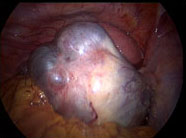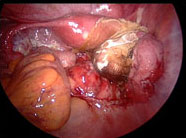This article discusses the symptoms, diagnosis and the various treatment options for endometriosis including both medical and surgical interventions.
Endometriosis - Contents
- Introduction to Endometriosis
- Symptoms of endometriosis
- Diagnosis of endometriosis
- Treatment of endometriosis
- Endometriosis and infertility treatment
- Conclusion
Introduction
Endometriosis is defined as the presence of tissue or cells from the lining of the womb (endometrium) elsewhere in the body. It is most commonly found around the uterus and ovaries, but it can be located anywhere in the body except the spleen. In the ovary endometriosis can form cysts containing old blood, also known as chocolate cysts (endometrioma) due to the colour of the contents. When it is in the pelvis it may affect the bowel and the urinary tract (bladder and kidneys). Occasionally it is found in the navel or operation scars. When the tissue from the lining of uterus is found in the muscle layer of the uterus it is called adenomyosis. Sometimes endometriosis and adenomyosis can be found together in the same woman.
The tissue of endometriosis usually bleeds at the time as periods, similar to the normal endometrium. This bleeding is assumed to cause irritation and inflammation of the surrounding tissues, sometimes leading to pain, and also to scarring and sticking of tissues/organs to each other. Scarring in the pelvis may distort the pelvic anatomy and this may cause difficulty in getting pregnant. Deep endometriotic tissue can sometimes form small lumps called ‘nodules’.
Symptoms of endometriosis
Endometriosis is usually found in women of reproductive age. Whilst some women with endometriosis have no obvious symptoms others will experience pain during menstruation (dysmenorrhoea), painful sexual intercourse (dyspareunia) or difficulty in conceiving. Occasionally pain may last throughout the cycle. In addition to these classical symptoms endometriosis can also cause other symptoms depending on the location. For example bowel endometriosis may cause painful bowel motions, constipation or diarrhoea and rectal bleeding during menstruation.
Diagnosis of endometriosis

While symptoms of endometriosis may be helpful in raising suspicion of endometriosis, they are not specific to this condition. Similar symptoms may be experienced by women with other conditions such as irritable bowel syndrome or pelvic inflammatory disease. Clinical examination may be entirely normal, especially in women with early endometriosis. In some women it may be possible to feel an enlarged ovary due to endometriotic cysts, nodularity or scarring of endometriosis and a tilted backwards (retroverted) uterus with reduced mobility.
Diagnostic investigations usually include a pelvic (often transvaginal) ultrasound examination. Ultrasound scans are highly effective in detecting ovarian endometriotic cysts which have a typical appearance due to their content of old blood. In experienced hands an ultrasound examination may also detect adherence of the ovaries or bowel due to scarring. However, a significant number of women with endometriosis will have no abnormalities detectable on ultrasound scans. Pelvic magnetic resonance imaging (MRI) test may be helpful in certain situations.
The most reliable method of diagnosing endometriosis is a laparoscopy (endoscopic examination of the inside of abdomen). An endoscope is inserted through the navel under general anaesthesia. The same endoscopic approach may also be used for surgical treatment of endometriosis.
Treatment of endometriosis
Treatment needs to be tailored according to the patient’s symptoms, expectations and circumstances. The woman should be involved in the decision-making when selecting the appropriate treatment. Endometriosis may sometimes be an incidental finding and no treatment may be needed if the woman is entirely symptom free. When treatment is needed it is important to have a multidisciplinary approach to ensure that the woman has access to appropriate surgical or medical treatment expertise, pain management, psychological support and fertility advice. For this reason in many countries including the United Kingdom there is a trend towards establishing endometriosis centres where patients can find all this expertise in one place. These centres usually have gynaecological surgeons with advanced minimal access (keyhole) surgery experience, colorectal and urological surgeons, fertility specialists, pain management specialists, psychologists or counsellors, clinical nurse specialists and sometimes complimentary medicine practitioners.
Some women with symptoms suggestive of endometriosis may choose to have empirical treatment to control their symptoms with medication such as analgesics or the combined oral contraceptive pill. If the symptoms improve with this approach without significant side effects from these medications it would be reasonable to continue with it without an established diagnosis. However symptoms do not improve in some women, others may experience significant side effects of the medication and some simply may not be happy to take medicine without knowing what the cause of their symptoms is. In this situation it would be appropriate to consider a diagnostic laparoscopy. If the procedure is carried out by a gynaecologist with experience in laparoscopic treatment of endometriosis, it would be important to discuss possible treatment at the same time to avoid repeat surgery.
Surgical treatment of endometriosis
Surgical treatment of endometriosis is probably the most effective form of treatment. There is evidence from randomised controlled trials that surgical treatment is effective in improving pain associated with endometriosis. Comparative trials show improvement of pain or quality of life in approximately 60-70% of women following surgical treatment of endometriosis. Surgical treatment also improves chances of natural pregnancy in couples who have endometriosis associated infertility. A review of randomised controlled trials showed approximately 1.6 times higher spontaneous pregnancy rates following surgery for early endometriosis compared to no treatment. The evidence on the effectiveness of surgery in advanced endometriosis comes from retrospective case series and there are no randomised controlled trials.

The principles of endometriosis surgery are elimination of endometriosis, separation of adhesions and restoration of normal pelvic anatomy. Elimination of endometriosis may be achieved either by excision (removal) or destruction of lesions. There is an ongoing debate amongst surgeons as to whether excision or destruction is better. Two similar randomised controlled trials demonstrated superiority of the excisional approach for treatment of ovarian endometriotic cysts. Patients who had their cysts removed had better spontaneous pregnancy rates and lower recurrence rates compared to those who had their cyst drained and inner surface cauterised. There is some concern about reduced ovarian function after removal of ovarian cysts, especially for patients who later need IVF (in vitro fertilisation) treatment. It is possible that ovaries from which endometriotic cysts have been removed may produce fewer eggs during IVF. However, overall pregnancy rates do not seem to be affected.
In contrast to treatment of ovarian endometriotic cysts, small controlled studies did not show significant differences between excision and cauterisation options for the treatment of early endometriosis outside the ovaries. For more advanced endometriosis, particularly those with deeply infiltrating endometriosis, such as rectovaginal and bowel nodules it is necessary to use the excisional approach, as these would be impossible to treat effectively with destruction methods.
Different surgeons use different techniques for the destruction or excision of endometriosis. For example, electrical diathermy, laser or ultrasound energy may be used to destroy endometriotic lesions. Similarly, ultrasound energy, laser or electrical diathermy may be used for excision techniques. There are no comparative trials demonstrating one source of energy is better than the others. Surgeons usually use a method they are most familiar with; the important principle is to ensure that endometriotic lesions are completely and safely eliminated whatever method is used.
When endometriosis affects bowel or the urinary tract it may be necessary to work with a colorectal or urological surgeon to achieve complete excision of the condition with the lowest risk of complications. This might be particularly helpful when bowel resection or treatment of endometriosis of the ureter is necessary.
Medical treatment of endometriosis
Some women choose medical treatment instead of surgery; medical treatment may also be necessary when symptoms persist after surgery or when surgical treatment is not possible or appropriate. The most commonly used medical treatment approaches are the combined oral contraceptive pill, levonorgestrel intrauterine system (Mirena®), gonadotrophin releasing hormone analogues (GnRHa) or progestogens (progesterone hormone derivatives). These options are usually equally effective in controlling the symptoms of endometriosis; however they do not eliminate it. Hence the recurrence of symptoms after discontinuation of treatment is very common. The side effect profile of these drugs varies and the duration they can be used depends on their side effect profile.
The combined oral contraceptive pill and Mirena® have good safety profiles and they can be used indefinitely. There is some recent evidence that Mirena® is particularly effective as an adjunct to surgical treatment.
GnRHa switch off the ovaries temporarily, in other words induce a temporary menopause. For this reason they cause menopausal symptoms such as hot flushes and night sweats, in the long term they also cause bone density loss. Similarly, high dose progestogens have significant side effects such as weight gain, bloatedness, breast tenderness and reduced libido. Hence duration of use for these two groups of medication needs to be restricted.
A recent addition to the medical treatment options for endometriosis is aromatase inhibitors such as arimidex or letrozole. These drugs may particularly be helpful for a small group of women who still have symptoms of endometriosis after menopause.
Analgesic drugs are usually an essential part of medical treatment for patients with significant pain. Paracetamol, codeine, nonsteroidal anti-inflammatory drugs such as aspirin, ibuprofen, mefenamic acid or diclofenac may all be used for this purpose. Some women will benefit from complimentary treatment approaches, dietary changes and psychological support. Input from patients support groups would also be useful.
Endometriosis and infertility treatment
Some women with endometriosis will experience fertility difficulties. Medical (hormonal) treatment has no place in the treatment of endometriosis associated infertility. They all have contraceptive effects and would delay pregnancy; they do not increase the likelihood of pregnancy after discontinuation of treatment either.
As explained above surgical treatment of endometriosis is known to improve chances of spontaneous pregnancy. However some patients will require additional fertility treatment despite surgery. When pelvic anatomy is mostly normal or restored to a satisfactory normality and the fallopian tubes are patent (unobstructed), artificial insemination treatment in combination with fertility drugs (superovulation) is known to be effective. The purpose of superovulation treatment in this situation is to increase the number of eggs released to achieve higher pregnancy rates. This approach carries a small risk of multiple pregnancy.
In patients with severely damaged pelvic anatomy, damaged fallopian tubes or when superovulation and intrauterine insemination treatment fails, in vitro fertilisation treatment will be needed. There is some debate as to whether women with endometriosis have lower chance of success with IVF. Reports from a number of fertility centres around the world suggest that endometriosis may be a factor which reduces IVF success. However, data from larger national databases such as the UK Human Fertilisation and Embryology Authority database suggest that women with endometriosis have similar outcomes to women without.
Conclusion
Endometriosis is a potentially chronic condition which may have a significant impact on a woman’s quality of life and fertility. A multidisciplinary approach which would place the woman at the centre of decision making is the best method of management. Individualised treatments which would address the woman’s symptoms, needs and expectations are likely to achieve more satisfactory results.
Do you still have questions? Complete our contact form and we will do all we can to help. For further information on endometriosis visit Endometriosis in the UK.
Key references
- Kennedy S, Berqvist A, Chapron C, D’Hooghe T, Dunselman G, Greb R, Hummelshoj L, Prentice A, Saridogan E. ESHRE Guideline for diagnosis and treatment of endoemtriosis. Hum Reprod 2005; 20:2698-2704
- Hart RJ, Hickey M, Maouris P, Buckett W. Excisional versus ablative surgery for ovarian endometriomata. Cochrane Database of Systematic Reviews. (2). CD004992, 2008
- Jacobson TZ, Barlow DH, Koninckx PR, Olive D, Farquar C. Laparoscopic surgery for subfertility associated with endometriosis. Cochrane Database of Systematic Reviews. (4). CD001398, 2002
For further information on the author of this article, Consultant Gynaecologist, Mr Ertan Saridogan, please click here.
The time of a woman’s life when her ovaries stop releasing an egg (ovum) on a monthly cycle, and her periods cease
Full medical glossary
